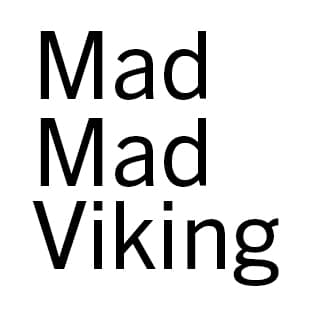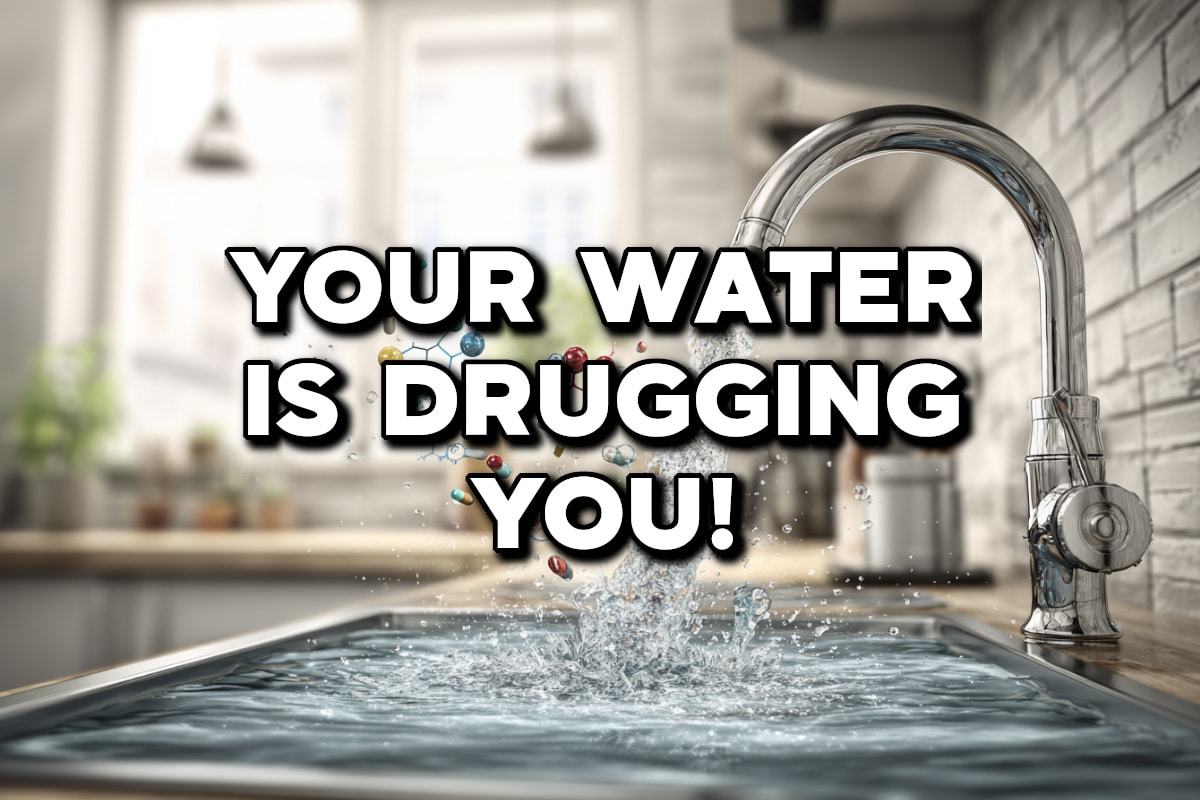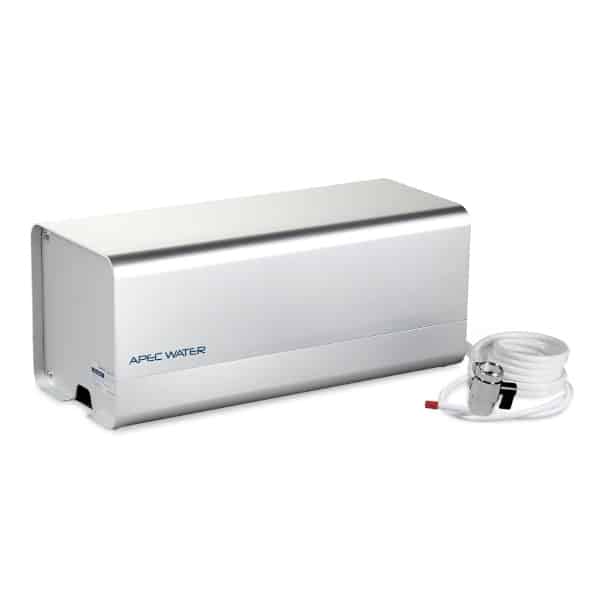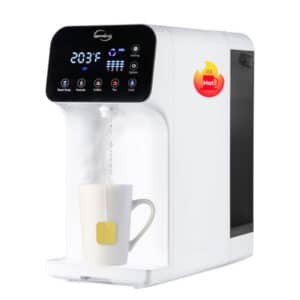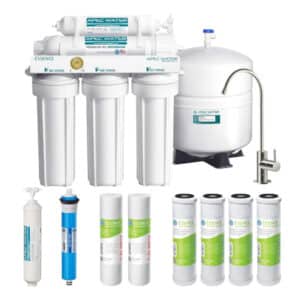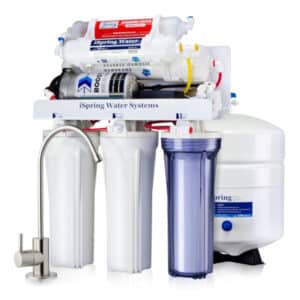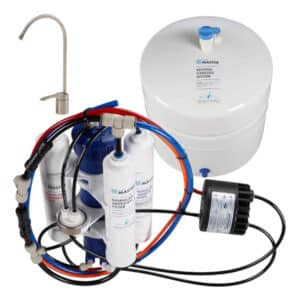Your morning coffee ritual just got a lot more complicated.
While you’re brewing that perfect cup, you’re also getting an unwanted cocktail of pharmaceuticals that your local water treatment plant couldn’t remove. We’re talking Prozac, birth control hormones, antibiotics, and pain relievers flowing straight from your tap.
Recent research from Poland confirms what many of us suspected: municipal wastewater treatment plants are failing spectacularly at removing common drugs from our water supply. In fact, some treatment processes actually increased pharmaceutical concentrations in the discharged water compared to what came in.
Having a Human Biology degree, I spend a lot of time reading up on health and science topics, but I’m not a doctor, so don’t take any of this as ‘medical advice.’ What I can tell you is that the science on pharmaceutical contamination in drinking water is both clear and disturbing.
How Your Water Gets Drugged
The contamination cycle is straightforward and unstoppable under our current system.
Every time someone takes medication, their body doesn’t absorb 100% of it. The excess gets excreted and flushed down the toilet. When you toss leftover pills down the drain instead of properly disposing of them, you’re adding to the problem.
But here’s the kicker: wastewater treatment plants weren’t designed to remove pharmaceuticals.
Municipal wastewater treatment plants are ineffective at removing Prozac (fluoxetine) and other common pharmaceuticals in wastewater, causing the drugs to be discharged into lakes, rivers and streams. The conventional mechanical-biological processes that work great for removing organic waste and bacteria are useless against synthetic pharmaceutical compounds.
The recent study found that only three pharmaceuticals were effectively removed during treatment: naproxen (Aleve), ketoprofen, and salicylic acid. Everything else passed right through. Worse yet, for some pharmaceuticals, including the antidepressant fluoxetine (Prozac), the pain reliever diclofenac, and the anti-seizure drug carbamazepine, the treatment processes actually led to higher levels of the compounds in the discharged water than in the original wastewater.
This treated wastewater gets discharged into rivers and lakes. Those same water sources get pumped back to drinking water treatment plants downstream, where the cycle continues. Water treatment plants are generally not equipped to remove medicines.
The result? Fluoxetine and the allergy drug loratadine (Claritin) posed the greatest risk to aquatic organisms, due to their ability to disrupt hormone signaling and development at the levels seen in the treated water.
If these pharmaceutical concentrations are messing with fish reproduction and development, what do you think they’re doing to you after decades of daily exposure?
Just How Bad Is Our Water?
The numbers are more disturbing than most people realize.
An Associated Press investigation found pharmaceutical contamination in the drinking water supplies of at least 41 million Americans across 24 major metropolitan areas. We’re not talking about isolated incidents – this is a nationwide crisis affecting major cities from coast to coast.
Here’s what they found flowing from American taps:
In Philadelphia, testing discovered 56 different pharmaceuticals or byproducts in treated drinking water, including medicines for pain, infection, high cholesterol, asthma, epilepsy, mental illness and heart problems. That’s 56 different drugs in what’s supposed to be “clean” drinking water.
Southern California’s treated drinking water, serving 18.5 million people, tested positive for anti-epileptic and anti-anxiety medications.
In Northern New Jersey, researchers found metabolized heart medication and the mood-stabilizing drug carbamazepine in drinking water serving 850,000 people.
San Francisco’s drinking water contained detectable sex hormones.
Washington, D.C. and surrounding areas tested positive for six different pharmaceuticals.
Tucson, Arizona had three medications, including antibiotics, in their drinking water supply.
These concentrations typically range from parts per billion to parts per trillion – sounds tiny, right? Here’s why that’s terrifying: Environmental Working Group analysis shows that of the top 200 drugs in the U.S., 13 percent list serious side effects at levels less than 100 parts-per-billion (ppb) in human blood, with some causing potential health risks in the parts-per-trillion range Pharmaceuticals Pollute U.S. Tap Water | Environmental Working Group.
What does this mean for your body? These are chemicals that are designed to have very specific effects at very low concentrations. That’s what pharmaceuticals do. So when they get out to the environment, it should not be a shock to people that they have effects NBC NewsPubMed Central. We’re talking about hormone disruptors, antibiotics that can promote resistance, antidepressants, blood thinners, and epilepsy medications – all flowing from your kitchen tap.
The most frequently detected compounds include carbamazepine (anti-seizure/mood stabilizer), sulfamethoxazole (antibiotic), and hormones including estrogen from birth control pills. Studies of fish upstream and downstream of wastewater treatment plants have found more female and intersex fish downstream from the plants, presumably because of the higher estrogen levels in the downstream water Drugs in the water – Harvard Health.
If pharmaceutical concentrations in water are literally changing the sex characteristics of fish, what do you think decades of daily exposure is doing to you and your family?
The reality is stark: you’re getting a low-dose pharmaceutical cocktail with every glass of water. No doctor prescribed it. No pharmacist dispensed it. And unlike your prescribed medications, you have no idea what combinations you’re getting or how they might interact in your body over decades of exposure.
This isn’t a future problem. This is happening right now, in cities across America, flowing from millions of taps every single day.
And It’s Not Just Pharmaceuticals
While we’re focused on drug contamination, there’s another invisible threat in your water: microplastics.
Recent research found that a liter of bottled water included about 240,000 tiny pieces of plastic. These microscopic particles have been found in human blood, lungs, reproductive organs, and even brain tissue.
Scientists have estimated that adults ingest the equivalent of one credit card per week in microplastics. Studies suggest these particles could be linked to cancer, heart problems, and reproductive issues.
The double whammy of pharmaceutical residues and microplastics means your water is delivering a toxic cocktail that conventional treatment can’t touch.
Why Standard Water Filters Fail
That Brita pitcher on your counter? It’s not doing much against pharmaceuticals.
Standard activated carbon filters can remove chlorine and improve taste, but they’re inconsistent at best for pharmaceutical removal. No significant removal of pharmaceuticals was observed in batch experiments with sand under natural aerobic and anoxic conditions, and basic flocculation processes showed no significant elimination of the selected target pharmaceuticals.
Most countertop and pitcher filters use basic carbon filtration that might catch 20-70% of certain pharmaceutical compounds on a good day. That’s not good enough when you’re dealing with hormone disruptors and antibiotics.
The reality is harsh but simple: if you want to remove pharmaceuticals from your drinking water, you need reverse osmosis.
The Real Solution: Reverse Osmosis Systems
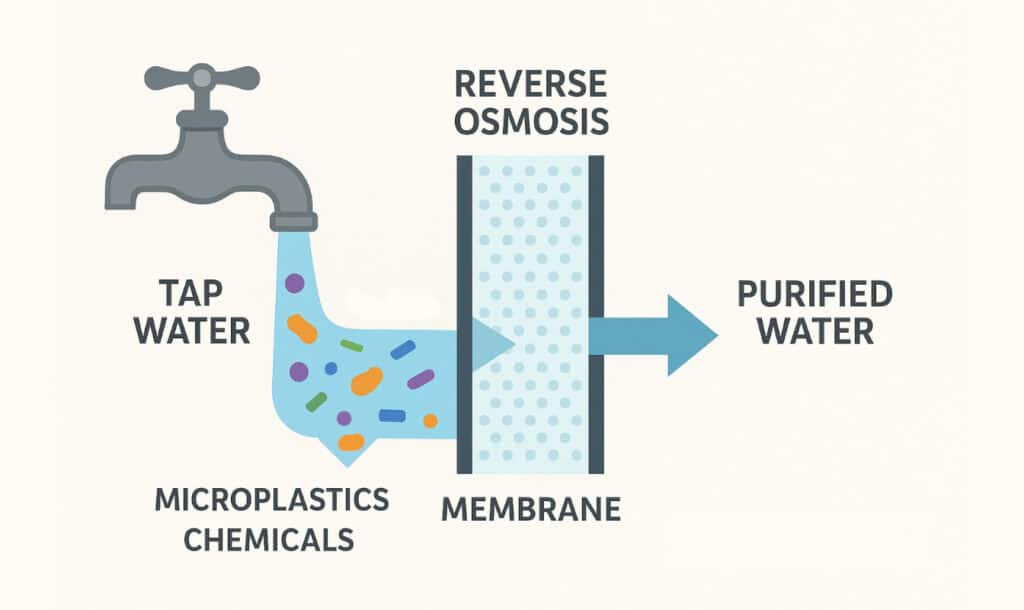
Reverse osmosis (RO) systems force water through a semi-permeable membrane that physically blocks pharmaceutical molecules. This isn’t about absorption like carbon filters – it’s about molecular size exclusion.
Multi-stage RO systems remove 90-99% of most pharmaceuticals, including the problematic ones that treatment plants can’t touch. The best systems combine RO with activated carbon pre- and post-filters for comprehensive protection.
Getting Pharmaceutical-Free Water in Your Home
Now that you understand the problem and know that reverse osmosis is the only proven solution, the question becomes: how do you actually implement this in your home?
You have two main options, each with distinct advantages depending on your living situation and water needs. The choice comes down to installation flexibility versus maximum performance.
Countertop vs Under-Sink: The Trade-Offs
Countertop Units: For Renters and Simplicity
If you can’t install permanent fixtures, countertop RO systems offer pharmaceutical removal without the commitment. They’re perfect for apartments or homes where you can’t modify plumbing.
The downside? Limited capacity and constant refilling. Most countertop units produce 1-2 gallons per day, which might not cover all your drinking and cooking needs.
Under-Sink Units: Maximum Protection
Under-sink systems are the gold standard for home pharmaceutical removal. They integrate with your existing plumbing and provide on-demand filtered water through a dedicated faucet.
These systems typically produce 50-100 gallons per day and include multiple filtration stages. The trade-off is installation complexity and higher upfront costs.
Smart Brand Selection: Think Long-Term
Here’s something most reviews don’t mention: choose established brands with readily available replacement filters.
Nothing’s worse than owning a great system that becomes useless because you can’t find replacement parts. Stick with brands that have been around for years and have wide distribution networks.
Top Countertop Recommendations
APEC Countertop RO System (ROCS-50)
The APEC RO-CTOP-C is a portable 4-stage reverse osmosis system that produces up to 90 gallons per day of pharmaceutical-free water without any permanent installation.
This lightweight 7-pound unit comes with a protective aluminum case and connects directly to standard faucets in minutes, making it perfect for renters, travelers, and anyone who can’t install under-sink systems.
- 4-stage RO filtration removes 99% of pharmaceuticals and contaminants
- No installation required – connects to standard faucets in minutes
- Established APEC brand with 20+ years experience and easy filter availability
- Portable design with aluminum case, perfect for apartments and travel
iSpring RCD100
The iSpring RCD100 is a premium 5-stage RO system with built-in UV sterilization and instant hot water dispenser that produces 100 gallons per day without any installation required. This plug-and-play unit features four temperature settings (room temp to 205°F), a smart display panel, and a 1.3-gallon storage tank with child safety locks.
- 5-stage RO filtration with built-in UV light removes 99% of pharmaceuticals and contaminants
- Instant hot water dispenser with 4 temperature settings (room temp to 205°F)
- Smart panel monitors filter life, temperature, and water levels with automatic self-cleaning
- Premium plug-and-play design with 1.3-gallon tank and established iSpring brand support
Waterdrop WD-M1
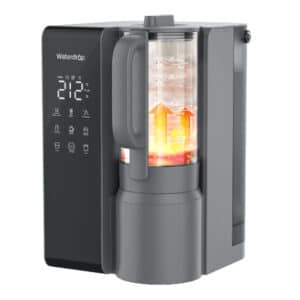
The Waterdrop K19-H is a 4-stage countertop RO system with built-in UV sterilization and instant hot water capability that heats water to your desired temperature in just 3 seconds.
This plug-and-play unit features a large 170oz (5L) capacity tank, smart digital display, and an efficient 3:1 pure-to-drain ratio for maximum water savings.
- 4-stage RO filtration with UV sterilization removes 99% of pharmaceuticals and contaminants
- Instant hot water dispenser with 4 temperature settings (room temp to 203°F)
- Large 170oz capacity tank with smart display showing TDS levels and filter life
- Efficient 3:1 pure-to-drain ratio and annual filter replacement for low maintenance
Top Under Sink Recommendations
APEC Water Systems ROES-50 Essence Series
The APEC ROES-50 is a reliable 5-stage under-sink reverse osmosis system that produces 50 gallons per day and has been WQA Gold Seal certified to remove up to 99% of contaminants including pharmaceuticals, heavy metals, and chemicals. This affordable workhorse from the established APEC brand features premium US-made filters and has earned a reputation as one of the most popular and dependable RO systems on the market.
- 5-stage filtration with high-rejection RO membrane removes 99% of pharmaceuticals and contaminants
- WQA Gold Seal certified to NSF/ANSI Standard 58 for proven performance and safety
- 50 GPD capacity with premium US-made filters and leak-proof fittings
- APEC’s 20+ year reputation with lifetime customer support and easy DIY installation
iSpring RCC7P-AK
The iSpring RCC7P-AK is a 6-stage under-sink RO system with built-in booster pump and alkaline remineralization that produces 75 gallons per day while restoring healthy minerals for better taste and pH balance. This NSF-certified system is specifically designed for low water pressure situations (below 40 PSI) and includes iSpring’s patented top-mounted faucet design for easier installation.
- 6-stage filtration with built-in booster pump removes 99% of pharmaceuticals and over 1,000 contaminants
- Alkaline remineralization stage restores healthy minerals and balances pH for natural taste
- Built-in booster pump works with low water pressure (below 40 PSI) for consistent performance
- NSF certified with iSpring’s 15+ year reputation and lifetime technical support from Atlanta, GA
Home Master TMAFC-ERP
The Home Master TMAFC-ERP is a premium 7-stage under-sink RO system with patented dual-pass remineralization that adds calcium and magnesium minerals twice during filtration for alkaline “mineral water on tap.” This system includes a non-electric permeate pump that achieves near 1:1 waste-to-pure water ratio while delivering exceptional 4.5-second fill rates through larger fittings and tubing.
- 7-stage filtration with patented dual-pass remineralization removes 99% of pharmaceuticals and adds healthy minerals
- Non-electric permeate pump achieves 1:1 waste ratio and prevents TDS creep for maximum efficiency
- Fast 4.5-second fill rate with larger fittings that double flow compared to traditional RO systems
- Made in USA with 5-year warranty, NSF certified components, and innovative modular design

Installation and Maintenance Reality Check
Under-sink systems require basic plumbing skills or a professional installation ($100-200). Most systems include detailed instructions and customer support. Budget $50-100 annually for filter replacements.
Countertop systems need zero installation but require counter space and regular refilling. Filter costs are similar, but you’ll use more due to smaller capacity.
Both options beat the long-term cost and environmental impact of bottled water while providing superior pharmaceutical removal.
Don’t Fall for the Bottled Water Trap
Before you think bottled water is the answer, think again.
Recent research found that a liter of bottled water included about 240,000 tiny pieces of plastic – that’s 10 to 100 times more plastic particles than previous studies found. Much of bottled water is just filtered tap water anyway, and there’s no universal standard for pharmaceutical removal.
Some bottled water companies use RO filtration, but many don’t. You’re paying premium prices for water that might contain the same pharmaceutical contamination as your tap, plus a massive dose of microplastics from the plastic bottle itself.
Quality varies drastically between brands, and you have no way to verify what’s actually been removed from any given bottle.
The Bottom Line
Your municipal water treatment is failing to protect you from pharmaceutical contamination. Standard filters can’t handle the job. And bottled water is expensive, environmentally destructive, and often just as contaminated.
The only proven solution for removing pharmaceuticals from drinking water is a multi-stage reverse osmosis system with activated carbon filtration.
Whether you choose countertop or under-sink depends on your living situation and water usage. But doing nothing means continuing to drink a daily cocktail of synthetic hormones, antidepressants, and antibiotics that your body was never meant to process.
Your health deserves better than hoping your local treatment plant figures it out.
Take action today: Research RO systems, check your local water quality reports, and stop gambling with your long-term health. Your body will thank you for taking control of what goes into it.
Want weekly no-BS health strategies that actually work for men over 40? Join the Freedom Over 40 newsletter for science-backed tips to reclaim your energy, health, and independence.
